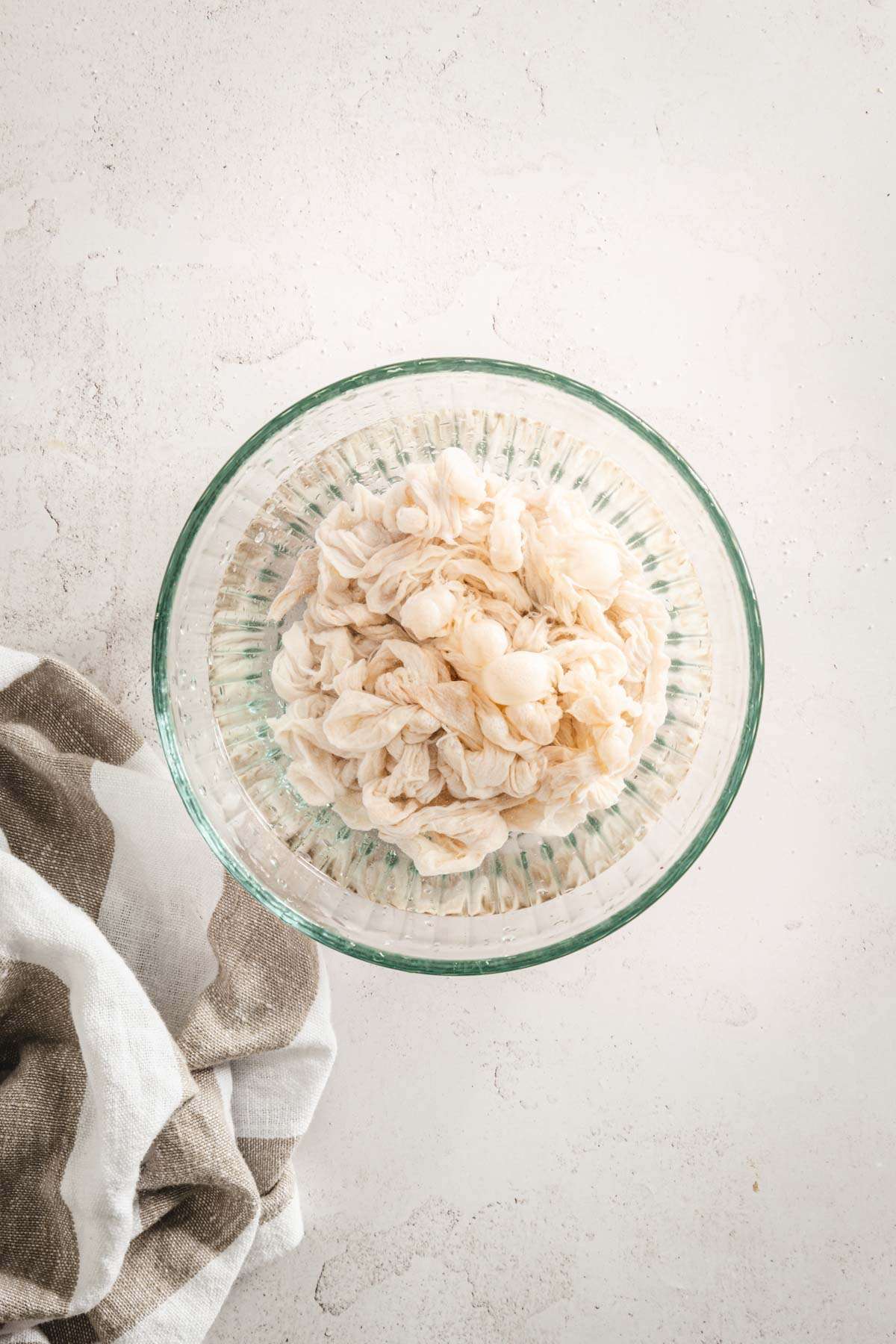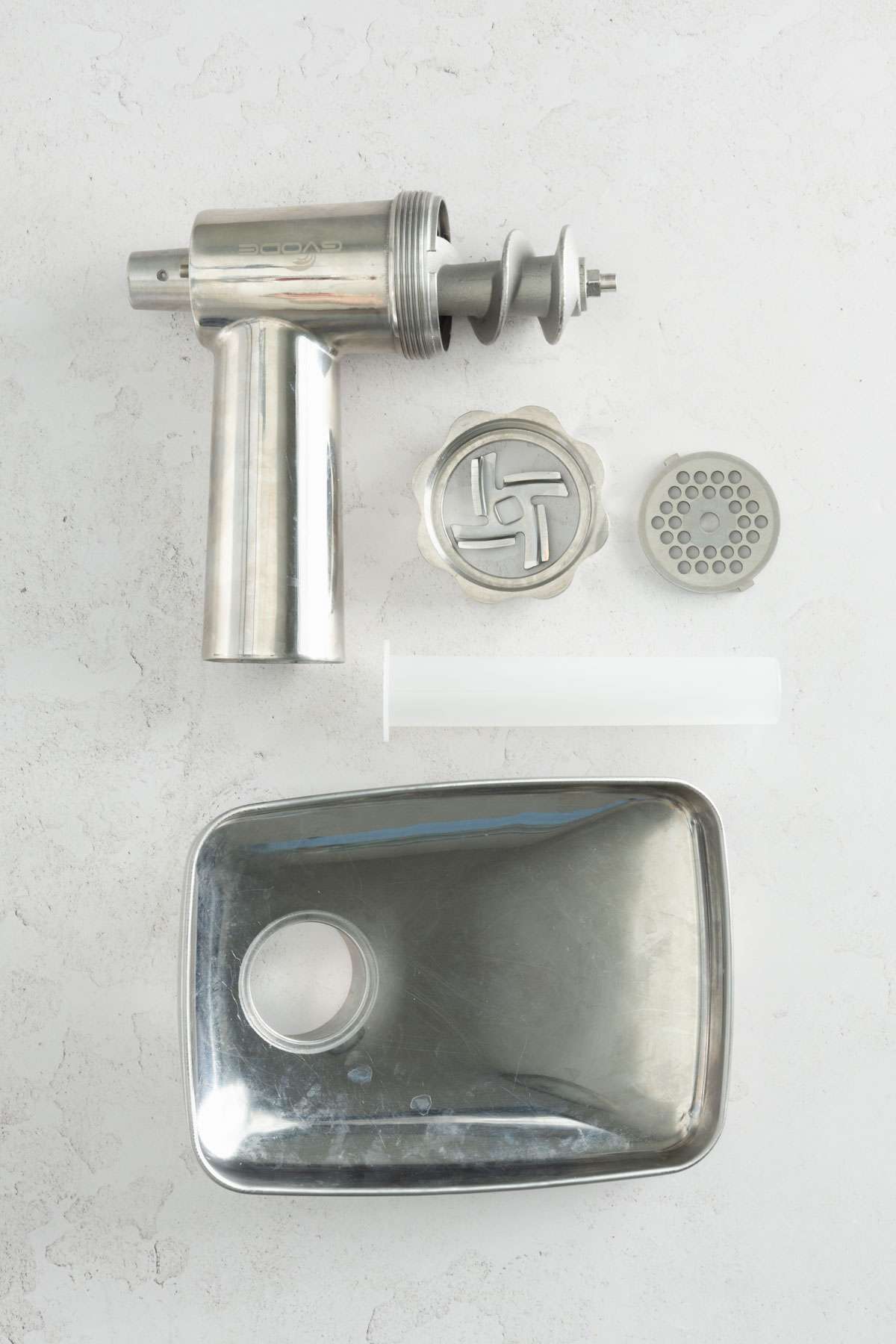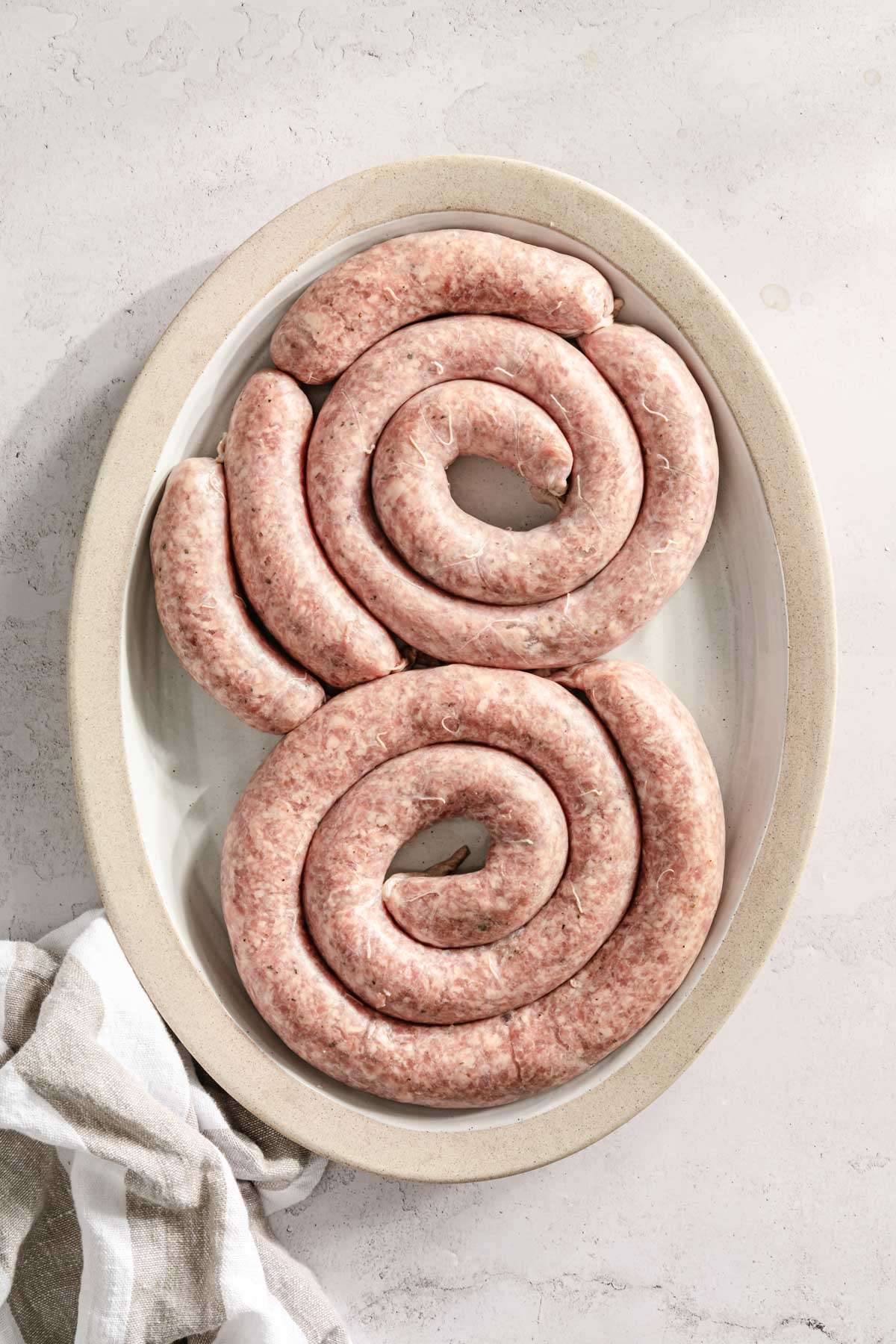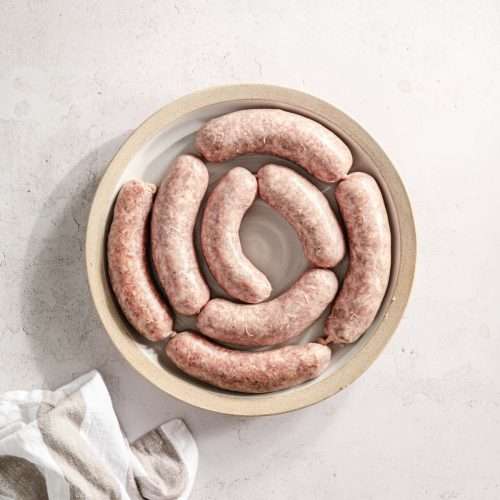Polish White Sausage – Biała Kiełbasa
Polish White Sausage – Biała Kiełbasa is one of those traditional, deeply rooted in Polish culture foods. It is different from any other sausage out there. Made of ground pork and seasoned with only a few aromatics, Biała Kiełbasa is delicate in taste. This Polish White Sausage is a favorite among sausage enthusiasts.
Polish sausage is a must for Easter or New Years celebrations. Poles love it so much that you will find it served more often, than twice a year. Great for grilling, added to soups or eaten for breakfast, it’s hard to beat fresh kielbasa!

Making sausage at home is easy, but a time consuming, elaborative task. The first time is usually the most difficult. You are using equipment for the first time, getting the hang of it and understanding the best ways of doing it. With each time it becomes easier. I promise you, it all is so worth it. Seeing it come together and then tasting it, so rewarding.
Why you will love Polish White Sausage:
Rich Flavor – this Polish sausage has a wonderfully rich flavor created by combining simple ingredients. Everybite delivers a perfect balance of savory meatiness with subtle spices.
Versatility – this Polish sausage incredibly versatile and can be enjoyed in various ways. Grilled, pan-fried, boiled, or incorporated into soups and stews.
Heritage and Tradition – this Polish sausage is deeply rooted in Polish culinary heritage and tradition. It truly is a special treat.
Simple Ingredients – made with pork, garlic, salt, pepper, and marjoram, it’s a straightforward and incredibly flavorful sausage.
Homemade and delicious – yes, the process of making kiełbasa at home is laborious, but so rewarding. Seeing it come together from simple ingredients is the best part.
Great for Sharing – served at family gatherings, barbecues, or casual get-togethers, Biała Kiełbasa is a crowd-pleaser. Its generous portions and delicious flavor make it perfect for sharing with friends and loved ones.

Ingredients, Variations and Substitutions:
Here’s what you need to make Polish white sausage:

Pork Shoulder and Pork Butt – cuts of pork are commonly used in making fresh sausage due to their balance of lean meat and fat. Pork shoulder provides flavor and juiciness, while pork butt adds additional fat for moisture and texture. It’s essential to have a good ratio of lean meat to fat for a juicy and flavorful sausage. Aim for a ratio of around 70% lean meat to 30% fat. If you can’t find pork shoulder or butt, you can use other cuts of pork with a similar fat content, such as pork loin or pork belly. Just be mindful of adjusting the fat content accordingly.
Pork Belly – adds richness and succulence to the sausage. Fatty layers and marbling contribute to a moist and tender texture. Ensure the pork belly is well-trimmed and cut into smaller pieces to facilitate grinding and mixing. If pork belly is unavailable, you can use additional pork shoulder or pork butt to maintain the desired fat content.
Garlic – adds savory depth and aromatic complexity to the sausage. It’s a staple ingredient in many sausage recipes. Use fresh garlic cloves and finely mince or crush them for optimal flavor dispersion. If you’re not a fan of garlic or prefer a milder flavor, you can reduce the amount or omit it altogether.
Marjoram – aromatic herb with a flavor reminiscent of oregano but milder and sweeter. Use fresh or dried marjoram according to your preference and availability. Adjust the amount based on your taste preferences. If you don’t have marjoram, you can substitute it with oregano or thyme, although the flavor profile will be slightly different.

Mustard Powder – contributes a subtle tanginess and pungency to the sausage, enhancing its flavor profile. Adjust the amount of mustard powder to taste, as its intensity can vary depending on the brand and freshness. If you prefer, you can use prepared mustard instead of mustard powder.
Salt – essential for seasoning the sausage and enhancing its flavor. It also helps with protein extraction and binding. Use kosher or sea salt for optimal flavor and texture control. Avoid iodized salt, as it can impart off-flavors. There’s no direct substitution for salt, as it’s a fundamental ingredient. However, you can adjust the amount according to your taste preferences.
Black Pepper (Coarse Ground) – adds a bold, peppery flavor and specks of color to the sausage. Use freshly ground black pepper for the best flavor and aroma. Coarse ground pepper provides texture and visual appeal. If you prefer a milder pepper flavor, you can use finely ground black pepper or white pepper instead.
Natural Hog Casing – is used to encase the sausage mixture and give it its characteristic shape. It’s derived from the intestines of pigs and provides a natural casing that seals in moisture and flavor. Soak the hog casing in water before stuffing to soften and facilitate the stuffing process. Handle the casing carefully to prevent tears and ensure uniform sausage links. If hog casing is unavailable, you can use synthetic sausage casings or collagen casings as alternatives.
Cold Water – is added to the sausage mixture to help mixing and ensure proper hydration of the ingredients. Use cold water to maintain the temperature of the sausage mixture and prevent the fat from melting prematurely. You can experiment using other liquids such as beer, wine, or broth to add additional flavor to the sausage.
Equipment you will need:
- Meat grinder
- Sausage stuffer
- Sausage casing (natural hog casing or other natural casings)
- Chef’s knife
- Cutting board
- Food scale
- Large container, mixing bowl for the meat
- Measuring cups and spoons
- Sausage pricker or needle

Before you start, Top Tips for sausage making
Keep everything cold – the meat, the fat, the equipment throughout the entire process. This is crucial for several reasons. Food safety, we don’t want any bacteria to develop on the meat. Cold meat is also easier and faster to process, ensuring a good texture of the finished sausage. If you are making big batch, keep all the meat you are not currently processing in the freezer and equipment, like extra bowls in the fridge.
Proper Meat-to-Fat Ratio – is essential for flavor, juiciness, and texture of the sausage. Aim for a ratio of around 70% lean meat to 30% fat, but adjust according to your taste preferences and the type of sausage you’re making.
Grind the meat twice – this is optional, depending on the sausage you are making and personal preference. If you like a smoother and more uniform texture of kiełbasa, consider grinding the meat twice. Start with a coarser grind and then regrind it to the desired consistency. This helps distribute the fat evenly and ensures proper binding. I only ground it once using ⅜” plate
Season generously – don’t be shy with your seasonings! Sausage flavors can mellow during cooking, so season the meat mixture slightly more aggressively than you think is necessary. Remember to taste and adjust as you go.
Taste for seasonings before stuffing – cook a small portion of the sausage and adjust the seasonings as needed.
Avoid air pockets – when stuffing the casings, eliminate any air pockets by gently massaging and squeezing the sausage mixture as it’s being stuffed. Air pockets can cause the sausage to burst during cooking.
Don’t overstuff the casings – overfilling the casings can lead to bursting when cooking. You also need to be able to twist the sausage and create links. If the casing is too stuffed it will burst easily. Leave about 4-6 inches of casing empty at the ends. It will help when creating the links and in case you stuffed it too tightly.
Twist or tie off the ends – if making links, twist or tie off the ends of each sausage link to secure them and prevent them from unraveling during cooking.
Rest before cooking – let the stuffed sausages rest in the refrigerator for a few hours or best overnight before cooking to allow the flavors to meld and the sausage to firm up. Taste again the next day before stuffing.
Cook gently – when cooking Biała Kiełbasa sausage, avoid high heat, which can cause the casings to split. Instead, cook them over moderate heat until they’re cooked through and evenly browned.
Use a thermometer – to ensure that the kiełbasa is cooked safely, use a meat thermometer to check the internal temperature. Pork sausage should reach an internal temperature of 160°F (71°C).
Step by Step instructions for making Polish White Sausage (Biała Kielbasa)
- Start by gathering all your ingredients and equipment. Make sure you have large bowls – containers available to store the meat. Sharp knife, cutting board, paper towels, have them handy. If possible, prior to starting keep everything cold.
- Remove the meat from packaging. Trim excess fat if needed. Cut the meat into cubes or strips that will easily fit the feeding tube of the meat grinder.


- If working with a larger amount of meat, keep all the rest you are not processing at this moment in the fridge or freezer.
- Assemble the meat grinder. I used a medium size grinding plate. Arrange your workstation in a way that is easy for you to feed the grinder at a fast paste. If you are grinding a large amount of meat, keep all the rest in the fridge or freezer.
- You can also place the bowl – container with the cut up meat in a larger container filled with ice. This will keep the meat cold as you process it.
- I had two containers with cut up meat, one with the pork butt and one with the pork belly. While grinding I would alternate between the two to ensure even mixing of the lean and fatter meat.
- After all the meat is ground, add seasoning, spices, herbs. Mix well. You can also add the seasoning while grinding the meat.



- Add ice cold water to the ground meat. Recommended amount is 3 tbsp per 1 lb. Mix all thoroughly by hand. This is when we are creating the protein bind, just like in bread. Mix, knead and fold
- Taste seasoning – cook a small portion of the seasoned meat in a skillet. Taste and adjust as needed.
- Cover the container with the ground meat tightly with a plastic wrap and place in the refrigerator overnight.
- After 24 hours of rest you can make the sausages. Taste again for seasoning and adjust if needed.
- If using natural hog casing, remove it from the package. Soak it first in cold water to soften it. Follow with rinse and soak of the casing until the soaking water is clear. It may take 2-3 times. Finish with running cold water throughout the inside of the casing. Beside rinsing it on the inside, you can also find any holes or leaks in the casing



- Assemble the sausage stuffer. Apply small amount of olive oil onto the feeding tube. This will help the casing move smother. Thread one end of the casing onto the sausage stuffer nozzle, leaving 4-5 inches hanging off the end.
- Begin to force meat into the casings, gradually feeding the meat mixture through the sausage stuffer. Using your hands regulate the speed and firmness of the stuffing. Make sure the casing is evenly filled and free of air pockets.



- Twist or tie off the filled casing at regular intervals to form individual sausage links. Inspect the links for air pockets. Using a needle or sausage pricker remove them. Gently compress the meat to fill in that space.
- Rest (yourself) and the sausages on a tray, refrigerated overnight


- Cook or freeze for later use
- If cooking I would recommend using broth as the liquid. Adding a few allspice berries, 1-2 bay leaves and a teaspoon of whole peppercorns will enhance beautifully the flavors of the kiełbasa. You can also cook in clear water.
- Simmer on low for 30-45 minutes, until they reach an internal temperature of 160°F (71°C).
- Transfer to a serving platter and enjoy!


You may also like:
If you like this polish white sausage recipe, check out these recipes!
Storage and reheating
- Storage of cooked Biała Kielbasa:
- Refrigeration: After cooking, allow the Biała Kiełbasa to cool completely before storing it. Wrap it tightly in plastic wrap or aluminum foil, or place it in an airtight container. Store it in the refrigerator for up to 3-4 days.
- Freezing: For longer-term storage, you can freeze Biała Kiełbasa. Wrap it tightly in plastic wrap, aluminum foil, or freezer paper, or place it in a freezer-safe container. Label the package with the date and store it in the freezer for up to 2-3 months.
- Reheating:
- Thawing: If frozen, thaw the Biała Kiełbasa in the refrigerator overnight before reheating. This gradual thawing helps maintain its texture and flavor.
- Storage of raw Biała Kielbasa:
- Refrigeration: Store the raw Biała Kiełbasa in the refrigerator if you plan to cook it within a few days. Transfer it to an airtight container or resealable plastic bag to prevent cross-contamination and odors from other foods
- Keep the refrigerator temperature at 40°F (4°C) or below to slow bacterial growth and maintain the quality of the sausage
- Use it within a few days of preparation.
- Handle the uncooked sausage with clean hands and utensils to prevent contamination. Avoid touching other foods or surfaces with hands that have come into contact with raw meat.
- Keep the raw Biała Kiełbasa separate from ready-to-eat foods, such as fruits, vegetables, and cooked meats, to prevent cross-contamination.
- Store the raw sausage on a refrigerator shelf rather than in the door, where temperatures may fluctuate more.
- Freeze it for longer-term storage. Wrap the sausage tightly in plastic wrap, aluminum foil, or freezer paper to prevent freezer burn and maintain quality.
- Date all the packages to keep track of its freshness. Frozen Biała Kiełbasa can be stored in the freezer for up to 2-3 months.
- When ready to use the frozen sausage, thaw it safely in the refrigerator overnight. Avoid thawing at room temperature, as this can lead to bacterial growth.

Ways to enjoy Biała Kielbasa
- Pan-Frying – slice Biała Kiełbasa into pieces cook on a frying pan over medium heat until heated through and browned on the outside. This method helps crisp up the casing and enhances the flavor.
- Grill Biała Kiełbasa on the grill for a smoky flavor. Grill the sausages over medium heat, turning occasionally, until heated through and grill marks appear.
- Boiling Biała Kiełbasa in water or broth. Bring a pot of water to a boil, add the sausages, , few allspice berries and whole peppercorns. Simmer on low until heated through.
- Microwaving – not the ideal method, but you can microwave sliced Biała Kiełbasa in you are in a hurry. Place the slices on a microwave-safe plate and heat on high for 1-2 minutes or until heated through.
- Serve with mustard, sauerkraut, grated horseradish, grilled onions, or crusty bread.
- Add to soups, like Zurek or stews, like this Easy Smoked Cabbage Stew


Polish White Sausage – Biała Kiełbasa
Equipment
- meat grinder
- sausage stuffer
- Sausage casing (natural hog casing or other natural casings)
- chef's knife
- cutting board
- food scale
- Large container, mixing bowl for the meat
- measuring cups and spoons
- Sausage pricker or needle
Ingredients
- 6 lb Pork shoulder
- 8 lb Pork butt
- 2.5 lb Pork Belly
- 3 tbsp Marjoram
- 1 tsp Mustard powder
- 5 Garlic
- 4 tbsp Salt
- 2 tbsp Black pepper coarse ground
- Natural hog casing
- 2 cup Cold water 3 tbsp per 1 lb of meat
Instructions
- Start by gathering all your ingredients and equipment. Make sure you have large bowls – containers available to store the ground meat. Sharp knife, cutting board, paper towels, have them handy. If possible, prior to starting keep everything cold.
- Remove the meat from packaging. Trim excess fat if needed. Cut the meat into cubes or strips that will easily fit the feeding tube of the meat grinder.
- If working with a larger amount of meat, keep all the rest you are not processing at this moment in the fridge or freezer.
- Assemble the meat grinder. I used a medium size grinding plate. Arrange your workstation in a way that is easy for you to feed the grinder at a fast paste. If you are grinding a large amount of meat, keep all the rest in the fridge or freezer.
- You can also place the bowl – container with the cut up meat in a larger container filled with ice, to keep the meat cold as you process it.
- I had two containers with cut up meat, one with the pork butt and one with the pork belly. While grinding I would alternate between the two to ensure even mixing of the lean and fatter meat.
- After all the meat is ground, add seasoning, spices, herbs. Mix well. You can also add the seasoning while grinding the meat.
- Add ice cold water to the ground meat. Recommended amount is 3 tbsp per 1 lb. Mix all thoroughly by hand. This is when we are creating the protein bind, just like in bread. Mix, knead and fold
- Taste seasoning – cook a small portion of the seasoned meat in a skillet. Taste and adjust as needed.
- Cover the container with the ground meat tightly with a plastic wrap and place in the refrigerator overnight.
- After 24 hours of rest you can make the sausages. Taste again for seasoning and adjust if needed.
- If using natural hog casing, remove it from the package. Soak it first in cold water to soften it. Follow with rinse and soak of the casing until the soaking water is clear. It may take 2-3 times. Finish with running cold water throughout the inside of the casing. Beside rinsing it on the inside, you can also find any holes or leaks in the casing
- Assemble the sausage stuffer. Before you thread the casing apply small amount of oil to the feeding tube. It will help prevent the casing from breaking. Thread one end of the casing onto the sausage stuffer nozzle, leaving a few inches hanging off the end.
- Begin to force meat into the casings, gradually feeding the meat mixture through the sausage stuffer. Using your hands regulate the speed and firmness of the stuffing. Make sure the casing is evenly filled and free of air pockets.
- Twist or tie off the filled casing at regular intervals to form individual sausage links. Inspect the links for air pockets. Using a needle or sausage pricker remove them. Gently compress the meat to fill in that space.
- Rest (yourself) and the sausages on a tray, refrigerated overnight
- Cook or freeze for later use
- If cooking I would recommend using broth as the liquid. Adding a few berries of allspice, 1-2 bay leaves and a teaspoon of whole peppercorns will enhance beautifully the flavors of the kiełbasa. You can also cook in clear water.
- Simmer on low for 30-45 minutes, until they reach an internal temperature of 160°F (71°C).
- Transfer to a serving platter and enjoy!
Notes
Nutrition
Did you make this recipe?
Tag me @sylwiavaclavekphotography or tag me using #myomnikitchen so I can see your creations! You can also leave a comment below!

Conclusion
So yes, making sausage at home is a laborious task, but so rewarding, so satisfying in many ways. The accomplishment to see it all coming together, the ability to season it to your liking and to use best quality ingredients. All this so worth the 4-5 hours of work.
And don’t forget, if you love Polish cuisine and Polish recipes, don’t forget to sign up for my email list so you don’t miss a recipe!
FAQ about making Biała Kielbasa
What meat should I use?
Use a mix of lean meat and fat, such as pork shoulder and pork belly, aiming for a ratio of around 70% lean meat to 30% fat for optimal flavor and texture.
What seasonings should I use?
Experiment with a blend of spices like salt, pepper, garlic, and marjoram. Adjust quantities to taste, but the classic Polish sausage includes these staples.
How do I grind the meat?
Use a meat grinder with different grinding plates for coarse and fine textures. Ensure meat and grinder parts are well-chilled to maintain consistency and avoid mushiness. Experiment with the grinding plates to find the texture of the sausage you like the most. Some people grind the meat twice. First time using coarse plate and following with fine plate to achieve desired texture.
How do I stuff the casings?
Stuff casings evenly, avoiding air pockets by slowly filling and gently massaging the sausage. Twist or tie off links to secure, ensuring uniformity.
What casings should I use?
Choose between natural hog casings for traditional authenticity or synthetic casings for convenience. Soak natural casings before use and handle carefully to prevent tears.
How do I cook sausages safely?
Cook sausages to an internal temperature of 160°F (71°C) using methods like grilling, pan-frying, or boiling. Ensure even cooking and use a meat thermometer for accuracy. Read more HERE about cooking Polska Kielbasa.
How should I store sausages?
Refrigerate raw sausages for up to 3-4 days or freeze for longer-term storage, wrapping tightly to prevent freezer burn. Thaw in the refrigerator overnight before cooking. Read more HERE about storage and reheating of Polska Kielbasa.
Can I make sausage without a meat grinder?
Yes, use a food processor for a coarse grind or purchase pre-ground meat. However, grinding at home offers more control over texture and flavor..
Can I customize this recipes?
Absolutely! Modify recipes to suit your taste preferences by adjusting spices, herbs, and meat selections. Be creative and experiment with different flavor combinations.








